Team Members
-
Prof. Marwan Krunz (PI)
-
Prof. Hao Xin (Co-PI)
-
Dr. Ahmed Abdelrahman (Postdoctoral Researcher, 2015-2017)
-
Dr. Jinpil Tak (Postdoctoral Researcher)
-
Peyman Siyari (Graduate Student)
-
Adnan Kantemur (Graduate Student)
-
Elnaz Ershadi (Graduate Student)
-
Gitansh Gulati (Graduate Student)
-
Dr. Xiaoju Yu (Former Graduate Student, 2015-2016)
Partners
-
Dr. Diep Nguyen, University Technology Sydney (UTS)
Summary
Over the last two decades, dynamic and opportunistic spectrum access (DSA/OSA) has been advocated as a new paradigm for improving the utilization of the licensed spectrum below 6 GHz. Spectrum regulators (e.g., FCC, NTIA, etc.) embarked on numerous initiatives that aim at identifying underutilized portions of the licensed spectrum and exploring new models for spectrum sharing among different types of users. These initiatives include the FCC's ruling on TV broadcast channels in the 54 to 698 MHz range (so-called TV whitespaces or TVWS), the FCC's Notice of Proposed Rule Making (NPRM) on the 3.55-3.65 GHz radar band (which lays the groundwork for coexistence between small-cell LTE systems, military radar, and other incumbent systems), and others. Similar initiatives are taking place in other regions of the world, such as the European Union (EU)'s efforts to explore the 2.2-2.3 GHz band for spectrum sharing between aeronautical telemetry radar and small-cell LTE systems. The role of radio spectrum as a critical economic growth engine was highlighted in the 2012 President's Council of Advisors on Science and Technology (PCAST) report, which recommended creating "the first shared-use spectrum superhighways."
Yet, despite this strong push, commercial DSA wireless services have not proliferated. This is in part due to the limited availability of TVWS in urban areas and, more critically, their spatial non-uniformity across the Continental US. Broadcast TV stations in the US are licensed to operate over 6 MHz wide (NTSC) channels that fall into four noncontiguous segments of the spectrum (52-72 MHz, 76-88 MHz, 174-216 MHz, and 470-698 MHz). In a given urban location, the number of TV channels available for opportunistic access can be as low as 2 to 4, after accounting for FCC protection rules (e.g., power masks, adjacent-channel interference, etc.) and "TV pollution" zones, i.e., areas where TV signals are not decodable but are strong enough to disrupt secondary (opportunistic) transmissions. Not only that these channels are too few, but they often have to be shared by several secondary users (SUs), raising the prospects of SU-SU interference. The non-contiguity of available TV channels further complicates matters, as complex carrier/channel aggregation techniques must now be used over a given link to achieve WiFi-comparable channel widths (e.g., 20 MHz and higher).
The overarching goal of the underlying project is to enable DSA operation over a large swath of the opportunistic spectrum below 6 GHz, including the UHF portion of TVWS (470-698 MHz segment), the 3.5 GHz radar band, as well as other bands in the 1 to 4.4 GHz range that may later become candidates for DSA. By aggregating different (not necessarily contiguous) portions of the RF spectrum at the same wireless device, we anticipate that variations in white/grey spaces can be significantly reduced, allowing for sustained DSA operation over a large geographical area. Enabling such operation while maintaining high link throughput requires advances in the following areas:
- Electrically small tunable antennas that allow for dynamic access to narrowband (e.g., 6 MHz) channels, but yet support a broad frequency range from 470 MHz to 4.4 GHz.
- Channel/carrier aggregation techniques for noncontiguous narrowband channels.
- Multi-channel MIMO functionality that allows a given secondary link to boost its throughput (via spatial multiplexing gain) and, simultaneously, minimize interference onto other coexisting systems (via MIMO precoding techniques).
The first capability is intended to beef up the agility of the secondary radio, allowing it (for example) to switch between TVWS and the radar band, on demand. The last two capabilities are intended to significantly increase the per-link throughput and reduce SU-SU interference. Through novel advances in the above areas, we plan to design, implement, and experimentally evaluate a multi-channel 2-by-2 MIMO system for DSA with a broad RF coverage. Our research agenda involves optimizations at both the signal level (via MIMO precoders) as well as the antenna level (via highly tunable small form-factor reconfigurable antennas).
Research Tasks & Progress
1. Reconfigurable Antenna Designs
In this thrust, we are designing and demonstrating novel reconfigurable antennas with high tunability and a wide frequency coverage (targetting a ratio of 10:1 or more between the high and low frequencies). Simultaneously, the antenna will have a small footprint to facilitate MIMO operation on mobile devices. An abstraction of the proposed antenna concept is shown in Figure 1. It combines an ultra-wide-band (UWB) monopole for the higher frequency band (e.g., 1-4 GHz with a 4:1 frequency coverage ratio) and a reconfigurable matching network for the lower frequency range (e.g., 470-1000 MHz). The matching network does not influence the antenna properties because its size is negligible compared to the antenna. Furthermore, since the antenna size is mainly determined by the higher frequency band, it will be much smaller than a conventional broadband antenna without a matching circuit. By switching to a reconfigurable matching network, the 4:1 frequency coverage ratio of the UWB monopole can be further increased by another 2:1 to 3:1. The switching time can be very fast (less than 100 ns). Using the matching network method, the instantaneous bandwidth is narrower but still sufficient for operation over 6-MHz TVWS channels. Therefore, the proposed antenna operates as a broadband antenna at the higher frequency segment and an adaptively tunable narrowband antenna at the lower frequency segment. More importantly, its footprint is determined only by the higher frequency part, which is expected to be in the order of a few centimeters.
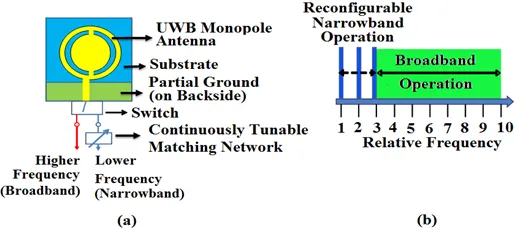

Figure 1: (a) Proposed antenna design for DSA with a 10:1 frequency-coverage ratio. The antenna switches between high-band operation, which is based on an UWB monopole antenna, and a low-band operation, which is based on an continously tuned (i.e., via semiconductor varactors) matching networks, (b) frequency operationof the proposed antenna. Narrowband channel aggregation in the lower band together with broadband operation in the higher band allow for a compact antenna footprint.
In order to extend the lower frequency operation of the antenna to approximately 400 MHz, a continuously tunable matching network, shown in Figure 2, was designed. A semiconductor varactor was used for capacitance tuning. By changing the bias voltage of the varactor, the operating frequency of the antenna varies continuously from 400 MHz to 1.2 GHz. MEMS switches were used in the design for discrete switching between the two operation modes, i.e., 400 MHz to 1 GHz and 1 GHz to 4 GHz. We also plan to augment our antenna design with advanced circuit configurations so as to achieve dynamically tunable channel aggregation of two or more TVWS channels.
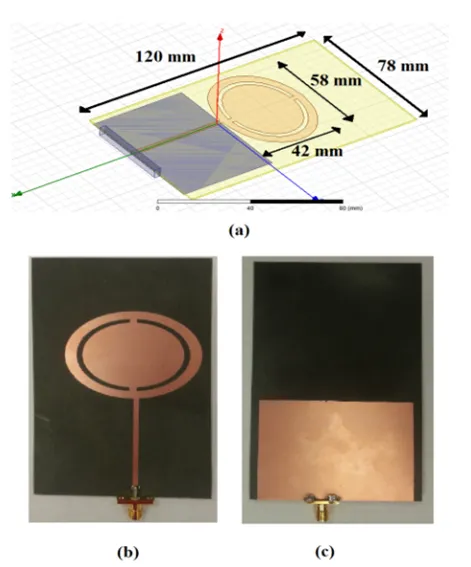

Figure 2: (a) Simulation model of the proposed UWB antenna, (b) top view of fabricated prototype, (c) bottom view of fabricated prototype.
While testing our abovementioned initial designs, we discovered several issues, including fabrication tolerances in the soldering process of surface mount switches and poor antenna radiation efficiency at low frequencies (400 MHz – 800 MHz) due to resistive losses in the lumped element components (capacitors, varactors and inductors). Consequently, we recently developed several new versions of the reconfigurable broadband antenna, with the intention to minimize loss and improve fabrication robustness. Two fabricated examples are shown in Figure 3. Based on the new antenna designs and reconfigurable matching circuits, four prototypes (representing two designs, Design A and Design B) with integrated semiconducting switches and varactor devices were fabricated and tested. Standalone antenna performance as well as system-level tests were performed. Figure 4 depicts the measured antenna return losses (solid lines) for the tunable low-band (varactor tuned LC matching) and the broadband high-band (direct path to the UWB antenna) for the one of the new designs. Simulated antenna return losses are also plotted on the same figures (dashed lines). It can be observed that the agreement between the simulation and measurement results is reasonable and this antenna is able to achieve satisfactory return losses from 600 MHz to beyond 4 GHz, with a form factor of about 10 x 6 cm2. The upshift in frequency for the measured response is attributed to fabrication tolerances.
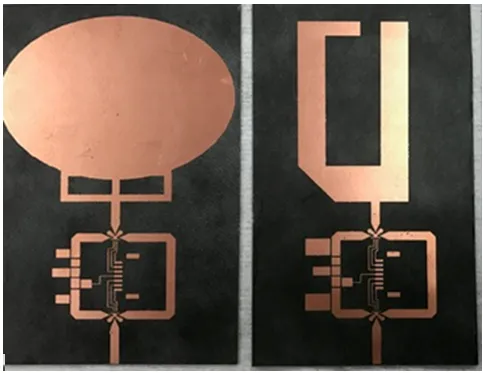

Figure 3: Two new improved reconfigurable antenna designs fabricated on PCB (without switches and varactors mounted).
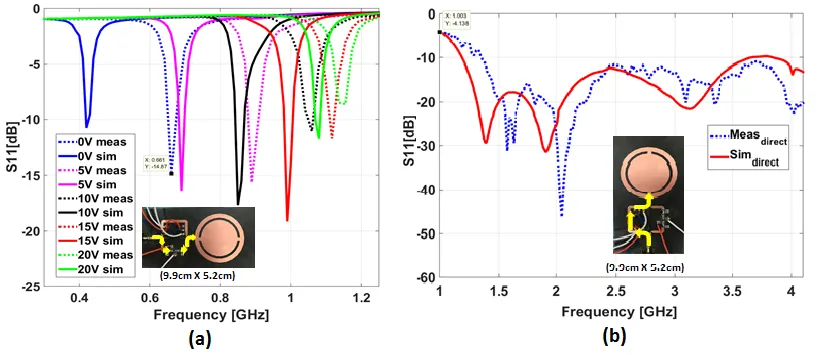

Figure 4: Measured and simulated antenna return loss for the: (a) tunable matching path (low band), and (b) direct path (high band).
2. Link-level Experiments Using Reconfigurable Antennas with Adjustable Carrier Frequencies
To test the link-level performance under our initial antenna designs, we conducted point-to-point data transmissions in which two NI-2922 Universal Software-defined Radio Peripherals (USRPs), produced by National Instruments Inc., were used to create a wireless link. Each USRP was interfaced with a novel reconfigurable antenna (see Figure 5) that can operate over a broad range of frequencies, between 510 MHz to above 4 GHz. The USRPs perform transmission/reception using separate computer programs written in LabView. Our primary performance metric is the bit error rate (BER). The following default settings were used: Tx-Rx distance = 5 feet, QPSK modulation scheme, and 20 MHz transmission bandwidth. The LabView code that drives the transmitting USRP takes care of pulse shaping, modulation, packet generation, and up-converting the baseband signal to a predetermined carrier frequency. The code corresponding to the receiving USRP performs down-conversion, demodulation, synchronization, and frequency offset estimation. In each experiment, 1000 data packets were transmitted, each containing 500 uncoded bits. Over the course of many simulations, we found out that by using the above mentioned packet size and modulation scheme, we can ensure that each packet encompasses one realization of the fading channel. Thus, the measured signal-to-noise ratio (SNR) after each packet reception reflects the SNR value for one fading realization, and so the average of all these SNR values over 1000 packet receptions is a good approximation of the average SNR of the experiment. Similarly, the BER for each packet transmission is the BER for each fading realization, and the average BER over 1000 packet receptions gives us the average BER for each experiment. Notice that each BER measurement must be performed under a predetermined carrier frequency. The BER measurements were done for the following carrier frequencies: 503 MHz, 700 MHz, 920 MHz, 1.05 GHz, 2 GHz, 3 GHz, and 4 GHz.
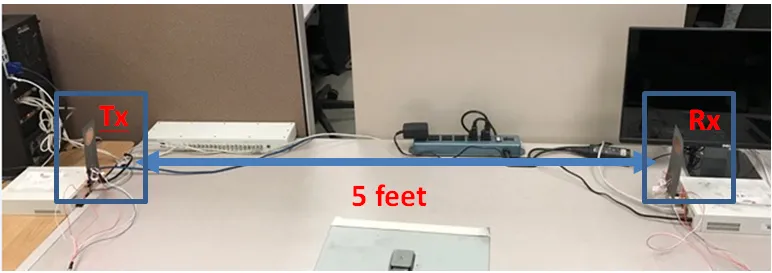

Figure 5: Experiment setup for testing the designed antennas using actual data transmissions.
Figure 6 depicts the average BER versus SNR for various carrier frequencies. Each point on a curve is obtained by averaging the BER values of 1000 packet receptions for the vertical axis, and the SNR values of all 1000 packet receptions for the horizontal axis. To change the average SNR, we control the receive power using the LabView code. Thus, by increasing/decreasing the received power, different average SNR values (and their corresponding average BERs) can be measured. The reason for adopting such an approach is that USRPs do not have the capability to change their transmission powers on a fine scale. Thus, adjusting the received SNR by modifying the power at the transmitter does not allow us to extract the general behavior of the link BER. Increasing/decreasing the receive power is done at the symbol level. Specifically, before the symbols inside a received packet are demodulated, we artificially inject additive noise to the received symbol, thus decreasing the received SNR. The artificial noise source is placed after the equalization stage. This way, the effect of the communication channel is compensated for at the equalization stage, which ensures that the communication channel is not involved when we adjust the received SNR, thus increasing the accuracy of our adjustments.
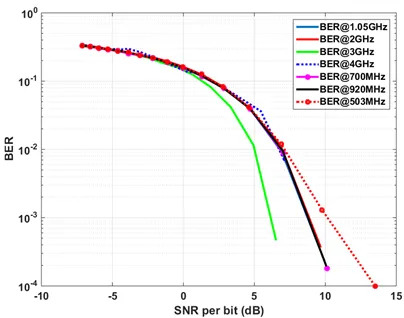

Figure 6: Average BER vs. average SNR for different carrier frequencies for a wireless link with reconfigurable antennas on both the Tx and Rx.
The above results indicate that our antennas are functioning well for all frequencies considered in this experiment, i.e., the well-known waterfall trend in BER curves as predicted in theory can be seen in the plots. There is a noticeable gap when the experiment was conducted at 3 GHz carrier frequency, which is under investigation.
3. MIMO Precoding Designs
This thrust focuses on exploiting the highly reconfigurable antennas of the previous thrust for real-time adaptation of the MIMO precoding parameters in a dynamic and multi-channel DSA system that operates over a broad frequency range. As a represntative system architecture, we consider a set of opportunistic MIMO-capable WLANs, each controlled by its own access point (AP). Within a given WLAN, three types of MIMO links may be established: downlinks (AP-to-MT), uplinks (MT-to-AP), and peer links (MT-to-MT). Two levels of resource contention exist in the underlying architecture: intra-cell (contention among links of the same WLAN) and inter-cell (contention among APs of different WLANs). To tackle the challenges presented by such an architecture, we follow a hierarchical approach, whereby intra-cell MIMO adaptations of a given WLAN are conducted first by the controlling AP (centralized approach). These adaptations are then used as input for inter-cell resource management, which is conducted in a distributed fashion following a price-based game theoretic approach (and while taking into consideration its implication on intra-cell CMIMO communications).
Because of antenna limitations, the study of MIMO precoding has largely been confined to single-channel systems. More recently, MIMO precoding was investigated in the context of multi-carrier MIMO-OFDM, but the focus was on narrowband channels (i.e., OFDM subcarriers over the same channel). Extending this treatment to the multi-band framework of this project is far from trivial, for a number of reasons. First, because of the drastically different propagation behaviors and fading conditions across bands, different encoders are needed for different channels. More importantly, it is not efficient to optimize the various precoders of a given link separately. Other challenges relate to incorporating the behavior of the reconfigurable antenna into precoder optimization. In particular, the variations in the antenna return loss across frequencies must be accounted for in the precoder design. Furthermore, while our antenna design supports channel aggregation (e.g., 2 to 4 TV channels) in the UHF TVWS segment, there is a tradeoff between the number of aggregated channels and the antenna efficiency. Such a tradeoff must also be accounted for in the optimization of the various precoders. The tasks that are being investigated in this thrust include:
- Optimal Precoders for Shared-Spectrum Intra-cell Cognitive MIMO Transmissions.
- Noncooperative Game Theoretic Precoder Designs for Inter-cell Communications.
- Optimal Precoder Designs for Cognitive MIMO Networks with Exclusive Channel Occupancy.
For Task 1, we consider a single WLAN, and focus on the best performance that this WLAN can achieve. Note that links within the WLAN can interfere with each other and may also have scheduling conflicts (e.g., several transmitters attempting to communicate with the same receiver). Besides power/spectrum adaptation of a typical DSA system, the cognitive MIMO (CMIMO) WLAN involves two additional controls: power allocation over antennas (a.k.a. stream control) and beamforming-based interference management; see Figure 7. The latter control allows a CMIMO link to configure its precoders so as to reduce interference on other links, i.e., facilitate SU-SU coexistence.


Figure 7: Control dimensions in a CMIMO WLAN: (a) Frequency allocation among multiple links, (b) power allocation over frequencies and antennas, and (c) beamforming-based interference suppression. The example shows a WLAN of 4 links, 2 antennas/node, and 3 channels.
To exploit the difference in channel quality among different links (so-called "multi-user diversity"), we augment the feedback from the spectrum database with a cooperative sensing and probing (CSP) mechanism, whose purpose is to allow different links in the same WLAN estimate the CSI of various channels. In this task, we allow various links to access the same spectrum, which leads to to mutual interference. Several scenarios and formulations are being addressed, depending on the target objective function and the optimization window (single or multiple rounds). Some of these formulations are non-convex, and hence quite challenging to solve in exact form. To address these challenges, we are investigating cooperative game theoretic designs, whereby iterative techniques (instead of a single-shot optimization) are used to obtain a near-optimal solution. The global optimization function is replaced by several (node-dependent) local optimization functions with appropriate constraints. Individual nodes perform localized computations and report the results to the AP, which then determines the final outcome. This approach is being applied to various objective functions. We are also exploring cooperative sensing and probing (S&P) strategies that are intended to supplement the coarse-grain database-acquired channel availability information. The proposed cooperative S&P protocol allows multiple links to concurrently sense and probe selected channels while minimizing the total time needed to acquire CSI for all channels over all links. It uses an adaptive control-frame structure whereby the sensing of certain channel/link combinations may often be skipped, depending on the likelihood of a change in the channel status (which is a function of the channel's coherence time and user dynamics). In contrast to classic S&P approaches in which periodic probing is performed over various channels indiscriminantly, in our scheme links are scheduled for sensing/probing processes so as to maximize the chances that the probed channels will meet the total rate demands of various SU links within a given sensing-time constraint.
Broader Impact
Integrating reconfigurable antennas in the design of a frequency-agile, MIMO-capable handheld wireless device represent new frontiers in radio design and opens the door for many possibilities for spectrum sharing and dynamic spectrum access. Up to now, it has not been possible to operate a wireless device over a broad range of frequencies (e.g., VHF to beyond UHF) without sacrificing size-weight-and-power (SWAP) aspects. Our initial designs, demonstrate the feasibility of a small form-factor reconfigurable antenna (~10 x 6 cm2 footprint) that can efficiently operate over a broad frequency range (600 MHz to 4 GHz) with good return losses. We hope that such findings will trigger significant interest from industry and the research community. For instance, it is now possible to envision an LTE-based smart phone that operates over the licensed spectrum of a wireless operator, but occasionally switches to the TV white spaces in the VHF band when the licensed cellular spectrum is crowded. We hope that our approaches for designing reconfigurable antennas while minimizing loss and improving fabrication robustness will inspire device manufacturers to consider practical ways to equip their radio platforms with reconfigurable antennas.
Related Publications
- Mohammed Hirzallah, Marwan Krunz, and Yong Xiao, "Harmonious cross-technology coexistence with heterogeneous traffic in unlicensed bands: Analysis and approximations," accepted for IEEE Transactions on Cognitive Communications (TCC), accepted for July 2019.
-
Mohammed Hirzallah, Yong Xiao, and Marwan Krunz, "MatchMaker: An inter-operator network sharing framework in unlicensed bands," accepted to appear in Proc. of IEEE SECON 2019, Boston, June 2019.
-
Peyman Siyari, Marwan Krunz, "Linear precoding with friendly jamming in overloaded MU-MIMO wiretap networks," accepted to appear in Proc. of the IEEE CNS 2019-Workshop on Physical-layer Methods for Security and Privacy in 5G and the IoT, Washington, DC, Jun. 2019.
-
Ahmed M. Salama, Ming Li, Loukas Lazos, Yong Xiao, and Marwan Krunz, ''Trading privacy for utility in database-assisted dynamic spectrum access,'' accepted for IEEE Transactions on Cognitive Communications and Networking (TCCN), May 2019.
-
Berk Akgun, Marwan Krunz, and Ozan Koyluoglu, "Vulnerabilities of massive MIMO systems to pilot contamination attacks," IEEE Transactions on Information Forensics & Security (TIFS), vol. 14, no. 5, pp. 1251-1263, May 2019.
-
Irmak Aykin, Berk Akgun, and Marwan Krunz, "Smartlink: exploiting channel clustering effects for reliable millimeter wave communications," in Proc. of the IEEE INFOCOM 2019, Paris, France, Apr. 2019, pp. 1117-1125 (acceptance rate 19.7%).
-
Peyman Siyari, Marwan Krunz, and Diep Nguyen, “Distributed power control in single-stream MIMO wiretap interference networks with full-duplex jamming receivers,” IEEE Transactions on Signal Processing (TSP), vol. 67, no. 3, pp. 594-608, Feb. 2019.
-
M. Hirzallah, W. Afifi and M. Krunz, "Provisioning QoS in Wi-Fi systems with asymmetric full-duplex communications," IEEE Transactions on Cognitive Communications and Networking (TCCN), vol. 4, no. 4, pp. 942-953, Dec. 2018.
-
Bushra Ismaiel, Mehran Abolhasan, Wei Ni, David Smith, Daniel Franklin, Eryk Dutkiewicz, Marwan Krunz, and Abbas Jamalipour, "PCF-based LTE Wi-Fi aggregation for coordinating and offloading the cellular traffic to D2D network," IEEE Trans. on Vehicular Technology (TVT), vol. 67, issue 12, pp. 12193--12203, Dec. 2018.
-
Y. Xiao, M. Hirzallah and M. Krunz, "Distributed resource allocation for network slicing over kicensed and unlicensed bands," IEEE Journal on Selected Areas in Communications (JSAC), vol. 36, no. 10, pp. 2260-2274, Oct. 2018.
-
Ahmed Salameh, Ming Li, Loukas Lazos, Yong Xiao, and Marwan Krunz, “On the privacy and utility tradeoff in database-assisted dynamic spectrum access,” in Proc. of the IEEE International Symposium on Dynamic Spectrum Access Networks (DySPAN’18), October 2018, Seoul, South Korea.
-
Mohammed Hirzallah, Yong Xiao, and Marwan Krunz, “On modeling and optimizing LTE/Wi-Fi coexistence with prioritized traffic classes,” in Proc. of the IEEE International Symposium on Dynamic Spectrum Access Networks (DySPAN’18), October 2018, Seoul, South Korea, pp. 1-10.
-
Irmak Aykin and Marwan Krunz, “FastLink: an efficient initial access protocol for millimeter wave systems,” in Proc. of the ACM International Conference on Modeling, Analysis and Simulation of Wireless and Mobile Systems (MSWiM 2018), Montreal, Canada, Oct. 2018, pp. 109-117 (received Best Paper Award).
-
Diep Nguyen, Marwan Krunz, and Eryk Dutkiewicz, "Full-duplex MIMO radios: A greener networking solution," IEEE Transactions on Green Communications and Networking (TGCN), vol. 2, issue 3, pp. 652--665, Sep. 2018.
-
Diep Nguyen, Eryk Dutkiewicz, and Marwan Krunz, “Harvesting short-lived white spaces via opportunistic traffic offloading between mobile service providers,” IEEE Transactions on Cognitive Communications and Networking (TCCN), vol. 4, issue 3, pp. 635--647, Sep. 2018.
-
Peyman Siyari, Marwan Krunz, and Diep Nguyen, “Power games for secure communications in single-stream MIMO interference networks,” IEEE Transactions on Wireless Communications (TWC), vol. 17, no. 9, pp. 5759-5773, Sept. 2018.
-
X. Yu and H. Xin, "Direction-of-arrival estimation enhancement for closely-spaced electrically small antenna array," IEEE Trans. on Microwave Theory and Tech, vol. 66, no.1, pp. 477-484, Jan. 2018.
-
Zaheer Khan, Janne Lehtomaki, Simon Scott, Zhu Han, Marwan Krunz, and Alan Marshall, "Distributed and coordinated spectrum access methods for heterogeneous channel bonding," IEEE Transactions on Cognitive Communications and Networks (TCCN), vol. 3, no. 3, pp. 267-281, Sept. 2017.
-
J. Wu, A. Abdelrahman, M. Liang, X. Yu, and H. Xin, "Monopole antenna radiation pattern control via 3D-printed dielectrics," IEEE Transactions on Antennas and Propagation, vol. 65, no. 8 , pp. 3869-3876, Aug. 2017.
-
G. Gulati, M. Liang, and H. Xin, "A conformal dual-polarized all-metal Vivaldi array for feeding broadband Luneburg lens," Proc. of the IEEE AP/URSI Symp., San Diego, July 2017.
-
Wessam Afifi and Marwan Krunz, "TSRA: An adaptive mechanism for switching between communication modes in full-duplex opportunistic spectrum access systems," IEEE Transactions on Mobile Computing, vol. 16, issue 6, pp. 1758-1772, June 2017.
-
Jocelyne Elias, Fabio Martignon, Lin Chen, and Marwan Krunz, "Distributed spectrum management in TV white space networks," IEEE Transactions on Vehicular Technology, vol. 66, issue 5, pp. 4161-4172, May 2017.
-
Mohammed Hirzallah, Wessam Afifi, and Marwan Krunz, "Full-duplex-based rate/mode adaptation strategies for Wi-Fi/LTE-U coexistence: A POMDP approach," IEEE Journal on Selected Areas in Communications (JSAC) - Special Issue on Spectrum Sharing and Aggregation for Future Wireless Networks, vol. 35, issue 1, pp. 20-29, Jan. 2017.
-
Mohammed Hirzallah, Wessam Afifi, and Marwan Krunz, "Full-duplex spectrum sensing and fairness mechanisms for Wi-Fi/LTE-U coexistence," Proc. of the IEEE GLOBECOM 2016 Conference, Washington D.C., Dec. 2016.
-
Mohammed-Amine Koulali, Essaid Sabir, Mounir Ghogho, and Marwan Krunz, "Towards a strategic satisfactory sensing for QoS self-provisioning in cognitive radio networks," Proc. of the IEEE GLOBECOM 2016 Conference, Washington D.C., Dec. 2016.
-
Wessam Afifi, Mohammed Hirzallah, and Marwan Krunz, "Integrating full-duplex capabilities in heterogeneous spectrum sharing," Proc. of the 50th Asilomar Conference on Signals, Systems and Computers, Pacific Grove, Nov. 2016.
-
Mahmoud Ashour, M. Majid Butt, Amr Mohamed, Tamer ElBatt, and Marwan Krunz, "Energy-aware cooperative wireless networks with multiple cognitive users," IEEE Transactions on Communications, vol. 64, issue 8, pp. 3233-3245, Aug. 2016.
-
A. Abdelrahman and H. Xin, "Design of double-layer transmitarray antenna using 3D printing technology," Proc. of the IEEE AP/URSI Symp., Puerto Rico, July 2016.
-
S. Ershadi, A. Abdelrahman, M. Liang, X. Yu, and H. Xin, "A novel reconfigurable broadband antenna for cognitive radio systems," Proc. of the IEEE Antennas and Propagation Symposium, Puerto Rico, July 2016.
-
Diep Nguyen, Marwan Krunz, and Stephen Hanly, "Distributed bargaining mechanisms for MIMO dynamic spectrum access systems," IEEE Transactions on Cognitive Communications and Networking, vol. 1, no. 1, pp. 113-127, Jan. 2016.
-
S. Ershadi, A. Keshtkar, A. Abdelrahman, X. Yu, and H. Xin, "Design of wideband unit-cell element for 5G antenna arrays," Proc. of the IEEE Asian Pacific Microwave Conference (APMC), Nanjing, China, Dec. 2015.
